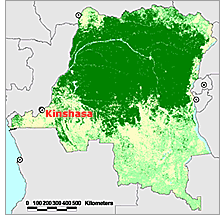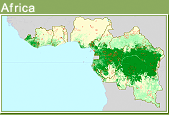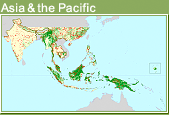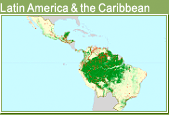Country details
Status of Tropical Forest Management 2005
Africa
Democratic Republic of Congo

©UNEP-WCMC 2004
The civil war took a heavy toll on DRC's infrastructure and development. Despite vast forest resources, the forestry sector failed to attract international investors or donors and remains undeveloped. There has been some improvement since 2002 (when the war ended) and the government has developed a policy aimed at encouraging the sustainable use of forest resources. The arrangements for forest and concession management and the enforcement of rules are currently in a state of flux; capacity for SFM remains minimal and its widespread adoption seems a long way off. Nevertheless, the forest sector has the potential (with appropriate planning and regulation) to play a crucial role in the country's recovery and subsequent development.
Key points
- DRC has vast closed tropical forests and a relatively low level of conversion to other uses, but the forest sector is in disarray as the country emerges from a long civil war.
- DRC has an estimated 47.6 million hectares of PFE, comprising 20.5 million hectares of production forest, 27.0 million hectares of protection forest and 55,000 hectares of industrial timber plantations.
- At least 284,000 hectares of the natural-forest production PFE are being managed sustainably, comprising three research and education forests. No areas of protection PFE are deemed to be so managed.
- Although not under formal management, large areas of DRC's forests are currently under no threat from deforestation or other significant human-induced disturbance due to their remoteness.
- Only one area of production forest, of about 1.1 million hectares, is covered by a management plan.
- Under the 2002 forest law, concessions of up to 500,000 hectares can be allocated for 25-year periods (renewable).
- Forestry administration is the responsibility of three directorates within the Ministry of Environment, Nature Conservation, Water Resources and Forests. A severe lack of capacity hinders efforts to supervise the forestry sector.
- The volume of timber harvested in DRC is only a tiny fraction of the potential sustainable yield, even accounting for likely significant levels of illegal logging.
- Four of the country's ten national parks are listed as UNESCO World Heritage sites; an estimated 9.32 million hectares of forest are contained in protected areas conforming to IUCN categories I–IV.

 Africa
Africa  Asia & the Pacific
Asia & the Pacific  Latin America & the Caribbean
Latin America & the Caribbean